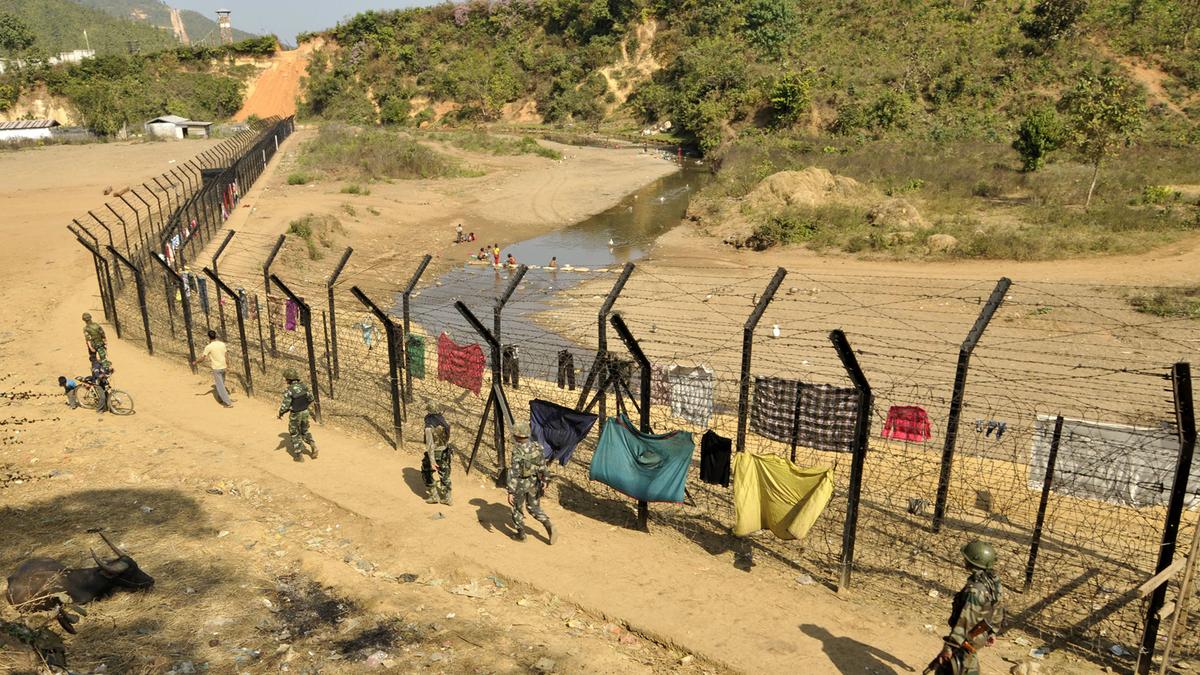India–Myanmar Free Movement Regime (FMR)

- 01 Apr 2025
In News:
In February 2024, Union Home Minister Amit Shah announced the scrapping of the Free Movement Regime (FMR) along the India–Myanmar border, citing national security concerns. The decision is reportedly influenced by the former Manipur Chief Minister, who blamed unregulated cross-border movement for ethnic violence in Manipur. However, the decision has not yet been implemented, and no formal notification or bilateral agreement has been issued. Mizoram and Nagaland have opposed the move, highlighting socio-cultural concerns.
What is the Free Movement Regime (FMR)?
- Introduced: 1968
- Current Limit: Movement up to 16 km on either side of the 1,643 km-long India–Myanmar border
- Eligibility: Members of hill tribes on both sides with a border pass valid for one year, allowing stay for up to 2 weeks per visit
- Purpose:
- Preserve historical, cultural, and familial ties between border communities
- Facilitate local trade and people-to-people exchanges
- Complement India’s Act East Policy by promoting cross-border cooperation
- Regulations: Initially 40 km (1968), reduced to 16 km (2004), with tighter checks from 2016
- Formal Implementation: 2018
Impact on Border Communities:
- Deep Ethnic and Familial Ties: Many communities across Mizoram, Manipur, Nagaland, and Arunachal Pradesh share ancestry and cultural links with communities in Myanmar, such as the Chin and Mizo peoples.
- Local Trade & Livelihoods: FMR supports livelihoods through informal trade. Its removal could disrupt economic dependence in these remote areas.
- Perceived as Redundant: Locals report that cross-border interaction predates FMR and continues with or without official sanction.
Security Concerns and Contraband Issues:
- Despite increased military presence post the Border Area Development Programme (BADP) in the 1980s, smuggling of contraband such as drugs, gold, and areca nuts continues unabated.
- Centre’s View: FMR allegedly facilitates illegal migration, drug trafficking, and infiltration contributing to internal instability.
- Local View: Scrapping the FMR alone won’t stop cross-border crime without comprehensive border management and community engagement.
Challenges with Border Fencing:
- Difficult Terrain: The mountainous and forested landscape makes border fencing logistically and financially challenging.
- Social Sensitivity: Fencing may provoke protests as the border cuts across ethnically unified communities.
- Unified Homeland Demand: Risk of reviving separatist sentiments, especially in regions like Eastern Nagaland, where demands for Frontier Nagaland exist.
Legal and Strategic Concerns:
- The Forest (Conservation) Amendment Act, 2023 allows the use of forest land within 100 km of international borders for strategic projects, raising concerns about displacement and loss of ancestral lands.
Way Forward:
- Balanced Approach Needed:
- Any changes must consider security needs as well as local sensitivities.
- Community engagement and consultation are crucial to avoid unrest.
- Alternatives to Fencing:
- Strengthen customs and intelligence units along the border.
- Promote legal trade channels to formalize economic activities.
- Enhance monitoring mechanisms without disrupting historical ties.
- Long-Term Strategy:
- Address instability in Myanmar, Chinese influence, and Golden Triangle drug trade through coordinated regional efforts.
- Align border governance with India’s Act East Policy, focusing on connectivity and cultural diplomacy.
Free Movement Regime (Indian Express)
- 25 Sep 2023
What is the News ?
The Chief Minister of Manipur recently stated that his government has requested the Union Home Ministry to discontinue the free movement arrangement along the India-Myanmar border and finalize the border fencing.
Facts About:
- The Free Movement Regime (FMR) allows all hill tribes, whether they hold citizenship in India or Myanmar, to travel within a 16 km radius on either side of the Indo-Myanmar Border (IMB).
- To cross the border, they need to present a border pass with a one-year validity issued by the relevant authority.
Each visit can last for up to two weeks.
- The FMR was put into effect in 2018 as part of the Central government's Act East policy.
- Both governments, India and Myanmar, implement the FMR for the benefit of the people residing along the IMB.
- This arrangement facilitates greater cultural integration among residents of trans-border villages.
They engage in activities like weddings, joint celebrations of festivals, and cross-border trade.
- The FMR underscores the physical, ethnic, linguistic, cultural, and fraternal connections among communities living across the border.
- Indo-Myanmar Border (IMB):
The IMB stretches over 1,643 km, traversing four states: Mizoram, Manipur, Nagaland, and Arunachal Pradesh.
It extends from the northern tripoint with China to the southern tripoint with Bangladesh.
The responsibility of guarding the IMB falls on the Assam Rifles.
